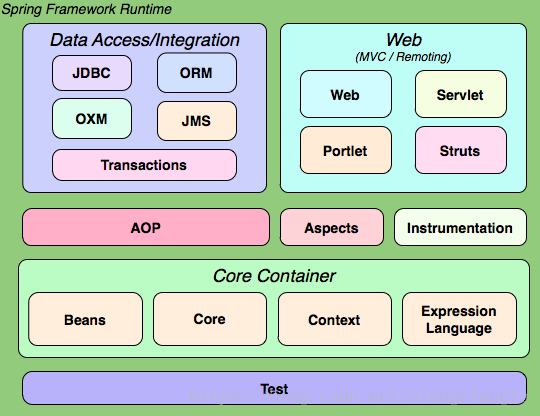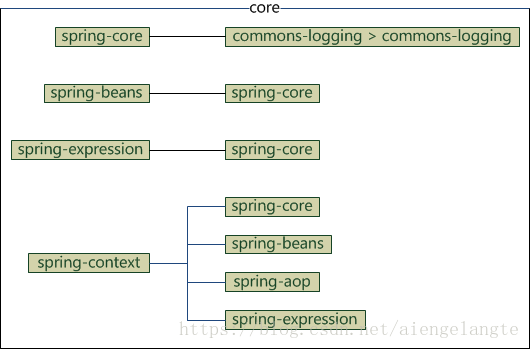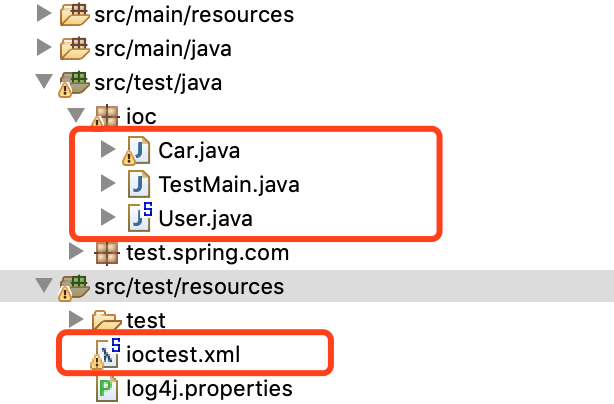spring介绍
spring是一个轻量级的开源框架(轻量级-指消耗资源少,开发过程快捷方便)
方便解耦,简化开发
Spring就是一个大工厂,可以将所有对象创建和依赖的关系维护,交给Spring管理。 --重点了解
AOP编程的支持
Spring提供面向切面编程,可以方便的实现对程序进行权限拦截、运行监控等功能。
声明式事务的支持
只需要通过配置就可以完成对事务的管理,而无需手动编程。
方便程序的测试
Spring对Junit4支持,可以通过注解方便的测试Spring程序。
方便集成各种优秀框架
Spring不排斥各种优秀的开源框架,其内部提供了对各种优秀框架的直接支持(如:Struts、Hibernate、MyBatis等)。
降低JavaEE API的使用难度
Spring对JavaEE开发中非常难用的一些API(JDBC、JavaMail、远程调用等),都提供了封装,使这些API应用难度大大降低。
spring体系

spring大致分为5个模块:Test、AOP、web数据访问、集成部分(Data Access/Integration)、核心容器(Core Container)
bean、core、context可以说是spring的三大核心组件这里详细的介绍下:
spring-core:依赖注入IoC与DI的最基本实现
spring-beans:Bean工厂与bean的装配
spring-context:spring的context上下文即IoC容器
spring-expression:spring表达式语言
盗一张别人总结的依赖关系图

所以当我们创建完spring项目后,pom.xml文件中自动添加了spring-context后,这样依赖的core、beans等jar包就全部导入了
<dependency> <groupId>org.springframework</groupId> <artifactId>spring-context</artifactId> <version>${spring.framework.version}</version> </dependency>
后续补充底层的实现原理
Spring最大的特性应该就是控制反转和依赖注入了
看了不下十几个对于这两个名词的解释,这里用自己的话概括下
控制反转:就是把创建对象的权利从自己交给外部的容器,不再由自己创建,控制权发生了改变
依赖注入:当运行一个A类需要依赖另一个B类的对象时,不需要自己new对象,而是通过容器控制程序创建对象B并注入到A里面
下面用xml配置的方式巩固对这两种设计的理解
基于xml配置Bean
这里先介绍下标签的基本含义
bean-定义一个Bean实例的信息 通俗的讲就是一个对象
bean属性:
id 指定生成的Bean实例名称
name 指定生成的Bean实例名称
scope 设定Bean实例的生成方式 默认是singleton模式 还有prototype多例模式 request、session、global session模式
init-method 初始化时调用的方法 比如对象中含有a方法,可以配置此属性这样每次生成对象时都会调用a方法
destroy-method 属性实例销毁时要调用的方法 同init-method 但是需要scope设置成singleton模式
bean子标签
property 官方的话术是用来配置Bean实例的依赖关系(set方式注入,属性一定要有set方法),通俗讲就是配置对象属性的值
constructor-arg 用来配置Bean实例的依赖关系(构造方式注入)
ref constructor-arg、property、list、set、entry等标记的子标记,指定一个Bean实例
value constructor-arg、property、list、set、entry等标记的子标记,指定一个常量
list 用以封装List或数组类型属性的依赖注入 具体的元素通过ref或value子标记指定
set 封装Set类型属性的依赖注入 具体的元素通过ref或value子标记指定
map 封装Map类型属性的依赖注入 应为map是键值对,需要用entry子标签设置“键/值”对
了解了标签基本的含义,现在实际操作下,先新建一个spring工程、在ioc的包下创建测试类User、Car;在resources下创建Spring Bean Configuration file模板的ioctest.xml文件

<?xml version="1.0" encoding="UTF-8"?> <beans xmlns="http://www.springframework.org/schema/beans" xmlns:xsi="http://www.w3.org/2001/XMLSchema-instance" xsi:schemaLocation="http://www.springframework.org/schema/beans http://www.springframework.org/schema/beans/spring-beans.xsd"> </beans>
package ioc; import org.springframework.beans.factory.annotation.Value; import org.springframework.stereotype.Component; public class Car { private String name; private double price; public Car() { } public Car(String name, double price) { super(); this.name = name; this.price = price; } public String getName() { return name; } public void setName(String name) { this.name = name; } public double getPrice() { return price; } public void setPrice(double price) { this.price = price; } @Override public String toString() { return "Car [name=" + name + ", price=" + price + "]"; }
}
User类,写的挺多,大部分都是set、get方法
package ioc; import java.util.List; import java.util.Map; import java.util.Set; public class User { private String name; private int age; private String sex; private Car car; private List<Integer> intlist; private List<Car> carList; private Set<Car> carSet; private Map<Integer, Car> carMap; //默认构造方法 public User() { } // 有参构造方法 public User(String name, Car car, List<Car> carList) { super(); this.name = name; this.car = car; this.carList = carList; } public List<Integer> getIntlist() { return intlist; } public void setIntlist(List<Integer> intlist) { this.intlist = intlist; } public String getName() { return name; } public void setName(String name) { this.name = name; } public int getAge() { return age; } public void setAge(int age) { this.age = age; } public String getSex() { return sex; } public void setSex(String sex) { this.sex = sex; } public Car getCar() { return car; } public void setCar(Car car) { this.car = car; } public List<Car> getCarList() { return carList; } public void setCarList(List<Car> carList) { this.carList = carList; } public Set<Car> getCarSet() { return carSet; } public void setCarSet(Set<Car> carSet) { this.carSet = carSet; } public Map<Integer, Car> getCarMap() { return carMap; } public void setCarMap(Map<Integer, Car> carMap) { this.carMap = carMap; } @Override public String toString() { return "User [name=" + name + ", age=" + age + ", sex=" + sex + ", car=" + car + ", carList=" + carList + ", carSet=" + carSet + ", carMap=" + carMap + "]"; }; public void init() { System.out.println("开始调用"); } public void destroy() { System.out.println("结束调用"); } }
<?xml version="1.0" encoding="UTF-8"?> <beans xmlns="http://www.springframework.org/schema/beans" xmlns:xsi="http://www.w3.org/2001/XMLSchema-instance" xsi:schemaLocation="http://www.springframework.org/schema/beans http://www.springframework.org/schema/beans/spring-beans.xsd"> <!-- 创建一个对象user 对象名称就是user 类名用class内容表示 要加上包名 --> <!-- scope设置成prototype表示每次调用都会生成一个新的对象 可以打印hashcode查看 --> <bean name="user" class="ioc.User" scope="prototype" init-method="init" destroy-method="destroy"> <!-- 构造函数参数的配置 --> <constructor-arg name="name" value="张三"></constructor-arg> <!-- 基本类型用value 引用类型用ref表示 --> <constructor-arg name="car" ref="car1"></constructor-arg> <constructor-arg name="carList"> <list> <!-- 可以在list中直接创建一个对象,但是外部无法使用 --> <bean id="car2" class="ioc.Car"> <property name="name" value="奔驰"></property> <property name="price" value="1000000"></property> </bean> </list> </constructor-arg> <property name="age" value="18"></property> </bean> <bean name="user2" class="ioc.User" init-method="init" destroy-method="destroy"> <!-- 通过属性的set方法给对象赋值 --> <property name="age" value="28"></property> <property name="name" value="王老五"></property> <property name="carSet"> <set> <ref bean="car1" /> <ref bean="car3" /> </set> </property> <!-- 给map类型的实例赋值 --> <property name="carMap"> <map> <entry key="1"> <ref bean="car1"></ref> </entry> <entry key="2"> <ref bean="car1"></ref> </entry> </map> </property> </bean> <bean id="car1" class="ioc.Car"> <property name="name" value="宝马"></property> <property name="price" value="500000"></property> </bean> <bean id="car3" class="ioc.Car"> <property name="name" value="特斯拉"></property> <property name="price" value="700000"></property> </bean> </beans>
重新配置xml文件后,写test类验证
package ioc; import org.springframework.context.ApplicationContext; import org.springframework.context.support.ClassPathXmlApplicationContext; public class TestMain { public static void main(String[] args) { //获取容器对象 ApplicationContext ac=new ClassPathXmlApplicationContext("ioctest.xml"); //通过容器获取配置的javabean User user=(User)ac.getBean("user"); System.out.println(user); User user2=(User)ac.getBean("user2"); System.out.println(user2); } }